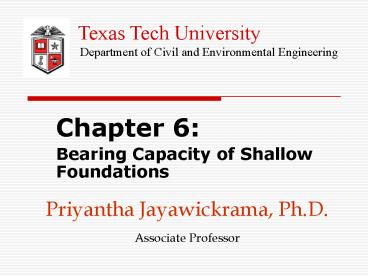Priyantha Jayawickrama, Ph.D. Associate Professor - PowerPoint PPT Presentation
1 / 34
Title:
Priyantha Jayawickrama, Ph.D. Associate Professor
Description:
Shallow Foundations Bearing Capacity The problems of soil mechanics can be divided into two principal groups - stability problems and elasticity problems ... – PowerPoint PPT presentation
Number of Views:109
Avg rating:3.0/5.0
Title: Priyantha Jayawickrama, Ph.D. Associate Professor
1
Priyantha Jayawickrama, Ph.D.Associate Professor
Texas Tech University
Department of Civil and Environmental Engineering
- Chapter 6
- Bearing Capacity of Shallow Foundations
2
Shallow Foundations Bearing Capacity
- The problems of soil mechanics can be divided
into two principal groups - stability problems
and elasticity problems - - Karl Terzaghi, 1943
3
Karl Terzaghi (1883-1963)
- Father of modern soil mechanics
- Born in Prague, Czechoslovakia
- Wrote Erdbaumechanick in 1925
- Taught at MIT (1925-1929)
- Taught at Harvard (1938 and after)
4
Karl Terzaghi at Harvard, 1940
5
Bearing Capacity Failure
6
Transcosna Grain Elevator Canada (Oct. 18, 1913)
West side of foundation sank 24-ft
7
Stability ProblemBearing Capacity Failure
- Chapter 6. Bearing Capacity Analysis
- How do we estimate the maximum bearing pressure
that the soil can withstand before failure occurs?
8
Bearing Capacity Failures
- Types/Modes of Failure
- general shear failure
- local shear failure
- punching shear failure
9
General Shear Failure
10
Punching Shear Failure
11
Model Tests by Vesic (1973)
12
General Guidelines
- Footings in clays - general shear
- Footings in Dense sands ( Dr gt 67)
- -general shear
- Footings in Loose to Medium dense
- (30lt Dr lt 67) - Local Shear
- Footings in Very Loose Sand (Dr lt
30)- punching shear
13
Bearing Capacity Formulas
14
Terzaghi Bearing Capacity Formulas
15
Terzaghi Bearing Capacity Formulas
For Continuous foundations
For Square foundations
For Circular foundations
16
Terzaghi Bearing Capacity Factors
17
Bearing Capacity Factors
18
Terzaghi Bearing Capacity Formulas
- D ? B
- No sliding between footing and soil
- soil a homogeneous semi-infinite mass
- general shear failure
- footing is very rigid compared to soil
19
Further Developments
- Skempton (1951)
- Meyerhof (1953)
- Brinch Hanson (1961)
- De Beer and Ladanyi (1961)
- Meyerhof (1963)
- Brinch Hanson (1970)
- Vesic? (1973, 1975)
20
Vesic? (1973, 1975) Formulas
Shape factors. Eq. 6.14, 6.15 and 6.16 Depth
Factors . Eq. 6.17, 6.18 and 6.19 Load
Inclination Factors . Eq. 6.20, 6.21 and
6.22 Base Inclinations factors .. Eq. 6.25 and
6.26 Ground Inclination Factors. Eq. 6.27 and
6.28 Bearing Capacity Factors . Eq. 6.29, 6.30
and 6.31
21
Vesic? Formula Shape Factors
22
Vesic? Formula Depth Factors
23
Bearing Capacity of Shallow Foundations
- 6.3 Groundwater Effects
- 6.4 Allowable Bearing Capacity
- 6.5 Selection of Soil Strength Parameters
- 6.6 Local Punching Shear Cases
- 6.7 Bearing Capacity on Layered Soils
- 6.8 Accuracy of Bearing Capacity Analyses
- 6.9 Bearing Capacity Spreadsheet
24
Groundwater Table Effect
25
Groundwater Table Effect Case I
- Modify ?'zD
- Calculate ?' as follows
26
Groundwater Table Effect Case II
- No change in ?'zD
- Calculate ?' as follows
27
Groundwater Table Effect Case III
- No change in ?'zD
- No change in ?'
28
Allowable Bearing Capacity
- .. Allowable Bearing Capacity
- F . Factor of safety
29
Factor of Safety
- Depends on
- Type of soil
- Level of Uncertainty in Soil Strength
- Importance of structure and consequences of
failure - Likelihood of design load occurrence
30
Minimum Factor of Safety
31
Selection of Soil Strength Parameters
- Use Saturated Strength Parameters
- Use Undrained Strength in clays (Su)
- Use Drained Strength in sands,
- Intermediate soils that where partially drained
conditions exist, engineers have varying
opinions Undrained Strength can be used but it
will be conservative!
32
Accuracy of Bearing Capacity Analysis
- In Clays ..Within 10 of true value (Bishop and
Bjerrum, 1960) - Smaller footings in Sands. Bearing capacity
calculated were too conservative but
conservatism did not affect construction cost
much - Large footings in Sands Bearing capacity
estimates were reasonable but design was
controlled by settlement
33
Accuracy Bearing Capacity Analysis
34
Bearing Capacity Spreadsheet
- Can be downloaded from http//www.prenhall.com/cod
uto - See Appendix B (page 848) for further instructions































